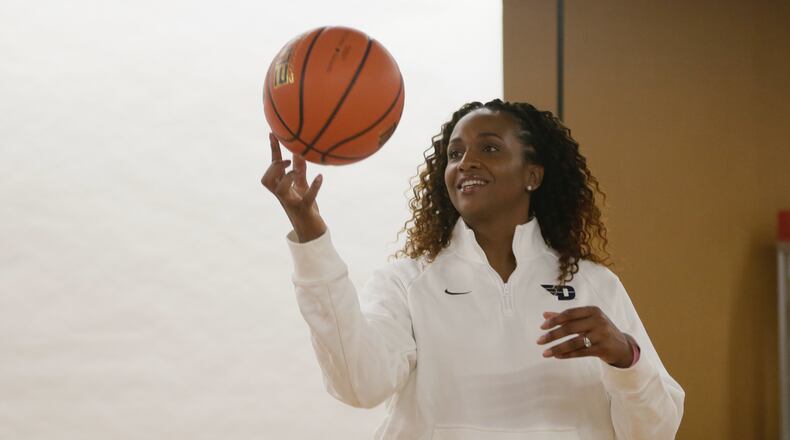When Williams-Jeter moved on to the WNBA, it was a different story. The top women’s basketball players in the world didn’t have the same luxuries their male counterparts had in the NBA, or even many of the top college teams had. Not until this year, when the arrival of college stars Caitlin Clark and Angel Reese elevated the profile of the league, did WNBA teams get to take private charter flights to games.
That’s just one of the changes that have come to the women’s game, which got more exposure over the summer at the Paris Olympics when the United States won its eighth straight gold medal. A new 11-year media rights deal with Disney, Amazon Prime and NBC will bring about $200 million to the WNBA on an annual basis and should result in higher salaries for players throughout the league.
Williams-Jeter retired from the WNBA in 2008 after a seven-year career. She is excited to see how much progress the league has made, especially in recent years.
“I wouldn’t take any of it back,” said Williams-Jeter, who’s entering her third season as the head coach at the University of Dayton. “It was a great experience to be from a small town like Dayton and to be a pro. But I’m so happy for the young women who will have a huge increase in pay. We’re not where the NBA is, but we’re only 25 years in. I’m excited about the charter flights, the benefits, the things you take for granted. I’m just so happy about all the attention — good or bad. It comes with the territory, just like with their male counterparts in the NBA. The amount of money they make, the amount of exposure, the amount of young girls who think they can get there, it’s just everything. I’m happy to have played a small part in helping them get there. It makes me smile watching it.”
There’s a long list of records and amazing stats associated with Clark and Reese entering the WNBA, which starts the playoffs today.
• On Aug. 30, a game between Clark’s Indiana Fever and Reese’s Chicago Sky drew 1.6 million viewers to the ION Network, setting a record for the channel and beating every college football game that aired that night in the ratings. Overall, ratings have risen 123% for the network.
• The Fever were averaging a league-best 16,979 fans per game in early September just two years after averaging 1,776 fans.
• Overall, the league is averaging 3,000 more fans per game than last season. The average attendance will be just under 10,000, the best number since the first two seasons of the WNBA’s existence in 1998 and 1999.
The rise of the WNBA isn’t the only sign of growth in women’s sports across the country.
• Participation in high school volleyball reached 470,488 in 2022-23, according to the National Federation of State High School Associations.
• Nebraska drew 92,003 fans, the largest crowd ever to witness a women’s sports event, to its football stadium for a volleyball match in 2023.
• Closer to home, the University of Dayton volleyball team drew a Frericks Center record crowd of 4,196 to a match against Ohio State earlier this season, though condensation on the court forced the teams to halt the match as a no-contest was declared.
Rikki Harris, a sixth-year guard on the UD basketball team who spent the last four seasons at Ohio State, has witnessed the increased interest in women’s sports.
“It’s definitely crazy,” Harris said. “I remember my first couple years in college, and we really didn’t get that much air time — maybe with some big games — but definitely my last two or three years there, it went from us being able to see every other seat to it being almost sold out every night. It was amazing to see the support for women go up overall. Almost every gym we played at had a great crowd.”
Williams-Jeter said she watches a lot of basketball, so she has seen Clark play. She also watches games involving Dallas Wings guard Jacy Sheldon, another rookie, because Williams-Jeter coached her at Ohio State early in her college career.
“The basketball world is such a small world,” Williams-Jeter said, “so it’s so much fun to watch these kids grow, and they have a lot of pressure I can’t even imagine — like with Caitlin Clark showing up to a gym and knowing the reason why it’s sold out is because you stepped into the gym.”
While Clark’s presence might be the reason for increased attendance, Williams-Jeter expects fans to return because of the overall quality of play.
“The best thing is that now the brand of basketball is very explosive and dynamic,” she said. “You have athleticism and above-the-rim play and sharpshooters.”
Fans will come for Clark, Williams-Jeter said, but stay for other reasons.
“I really like the energy and the sold-out crowds and season-tickets being sold out,” she said. “I never thought I’d see the day that would happen.”
Williams-Jeter spent one season at Wittenberg before getting the job at Dayton in 2022. The athletic director at Wittenberg who hired her, Brian Agler, also has an extensive WNBA background and an appreciation for how much progress the league has made.
Agler, a 1980 Wittenberg graduate, came back to his alma mater after 17 seasons in the WNBA. He had a record of 287-258 with four teams. He won his first championship with the Seattle Storm in 2010 and won another championship with the Los Angeles Sparks in 2016.
“I think it’s made a remarkable leap just this year,” Agler said. “A lot of that has to do with the college game and some of the talent that’s coming in and the visibility that those players are getting at the college level. The fan support at the college level draws the media, and then the media, they’ll follow the talent into the league. It’ll go from there. If the players really pan out and do well, then it seems to spike the interest.”
At Wright State and UD, athletic directors Joylynn Brown and Neil Sullivan hope more interest in the college game and the WNBA leads to increased interest in their women’s athletic programs.
Brown had the interim tag removed from her AD title in July. She took over the position in April when Bob Grant stepped down after a 16-year run as Wright State AD. She’s the first woman to hold the job at Wright State.
Brown believes the rivalry between Clark and Reese has drawn more eyeballs to the sport.
“In any sport — men’s sports, women’s sports — people love a great rivalry, so I think that’s part of it,” she said. “Women’s college basketball absolutely has blown up in the last couple of years as far as viewership. They’re taking all of these people that everyone is already familiar with and putting them in the WNBA and surrounding them with all professional athletes, and it’s making that level of play rise even more. I just think it’s a lot of fun. I don’t think it matters whether it’s men or women. People love competition. They love seeing people compete at a high level.”
Wright State averaged 1,543 fans in 16 home games at the Nutter Center last season. That was a significant increase over the 2022-23 season when it averaged 948 fans in 12 games.
Wright State ranked third out of 11 programs in the Horizon League. Green Bay led the league by averaging 1,964.
Brown also said season-ticket sales have increased entering the 2024-25 season.
“Once we get people into the arena,” Brown said, “they see the product and they see the kind of student athletes we have representing us and they come back. A lot of times people will bring their youth teams. If they have a girl who’s interested in playing sports, there’s nothing better than seeing a young woman that they can look up to.”
Dayton has led the Atlantic 10 Conference in women’s basketball attendance for 12 straight seasons, not counting the 2020-21 season when attendance was limited by the pandemic. The Flyers averaged 2,762 fans at 14 home games last season after averaging 2,574 fans at 13 home games the previous season.
“We’ve led the league in attendance for many, many years,” Sullivan said, “and we plan to do that again. We continue to try to grow that. ... I think first it’s just the talent of the young women in these sports. They’re unbelievably talented. They’re unbelievably gifted. The more people are willing to go to games and to support them the better.”
About the Author

